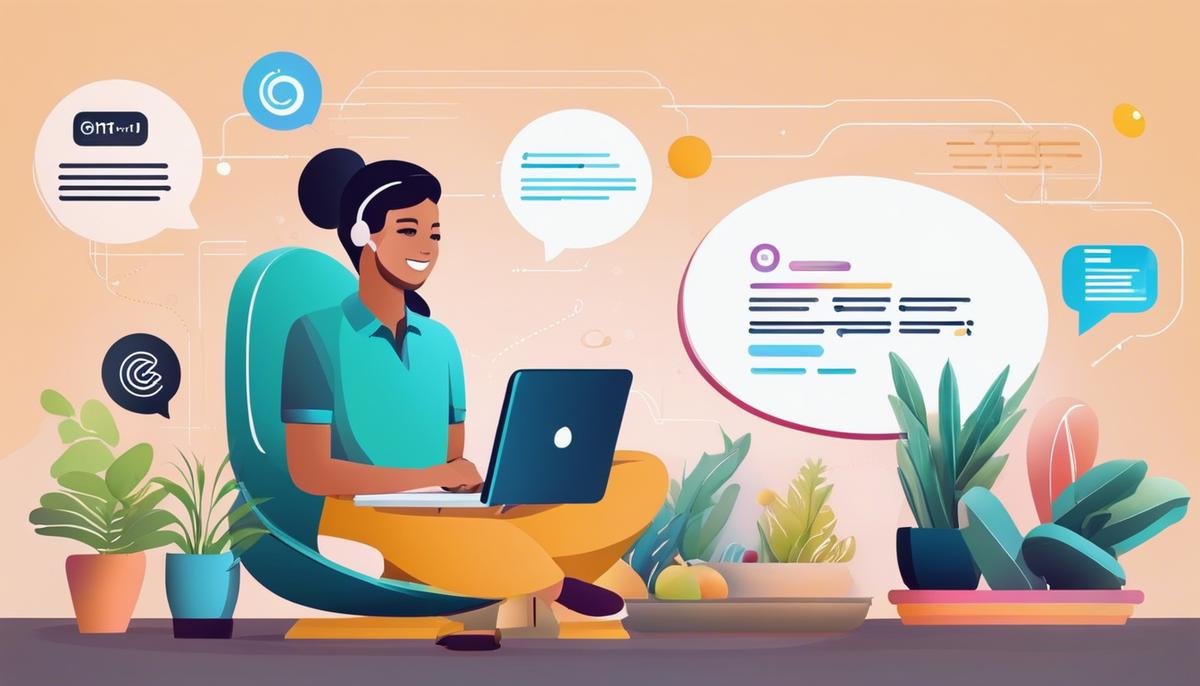In our modern era, AI chatbots are making a big splash in customer service, transforming the way businesses connect with their customers. These innovative tools provide quick, efficient support, making every interaction smoother and more satisfying. This article explores the incredible impact of AI chatbots, from their capabilities to their benefits, and how they’re reshaping the landscape of customer service one chat at a time.
Understanding AI Chatbots in Customer Service
AI Chatbots Revolutionizing Customer Service
In today’s fast-paced world, AI chatbots are transforming customer service, offering instant support and reshaping how businesses interact with their clients. These intelligent assistants are powered by Artificial Intelligence (AI), enabling them to understand and respond to customer inquiries in real-time.
At the core of this transformation is the ability of AI chatbots to provide 24/7 assistance. Unlike traditional customer service, which relies on human availability, chatbots are always on, ensuring customers can get help anytime, whether it’s the middle of the night or during busy holiday seasons. This round-the-clock availability significantly enhances customer satisfaction by providing immediate answers and solutions.
Moreover, AI chatbots can handle multiple inquiries simultaneously. While a human agent can only manage one conversation at a time, chatbots can engage with countless customers simultaneously, scaling customer service operations and reducing wait times drastically.
Customization is another area where AI chatbots excel. They can personalize interactions based on customer data, delivering tailored recommendations and support. For instance, if a customer frequently orders a particular item from an e-commerce site, the chatbot can provide updates on the availability or suggest similar products, creating a more personalized shopping experience.
AI chatbots also play a pivotal role in reducing operational costs. By automating routine inquiries, businesses can free up human agents to focus on more complex and sensitive issues. This not only improves efficiency but also allows companies to reallocate resources and invest in other areas of business development.
The integration of Natural Language Processing (NLP) technologies has significantly enhanced the capabilities of AI chatbots. NLP enables chatbots to understand and process human language more accurately, leading to more natural and engaging conversations. As these technologies continue to advance, we can expect AI chatbots to become even more sophisticated, further closing the gap between human and machine-led customer service.
One of the most notable impacts of AI chatbots is their ability to gather and analyze customer data. By monitoring interactions, chatbots can identify common issues, track customer satisfaction levels, and even predict future queries. This wealth of data provides invaluable insights for businesses, allowing them to improve their products, services, and overall customer experience.
In conclusion, AI chatbots are revolutionizing customer service by offering 24/7 assistance, handling multiple interactions at once, personalizing customer experiences, reducing operational costs, and providing valuable customer insights. As technology evolves, the role of chatbots in customer service will only grow, making them an indispensable tool for businesses looking to stay competitive in the digital age.

Ada’s AI Chatbot Features and Capabilities
Leveraging Ada’s AI chatbots, businesses have transformed the way they engage with customers, providing a seamless, round-the-clock service that was previously unthinkable. What truly sets Ada’s chatbots apart is their ability to deeply understand and instantly respond to customer queries. But what further elevates Ada above the standard AI chatbot offerings?
A key distinguishing feature is Ada’s user-friendly design, aimed at empowering non-technical staff to build and manage chatbots with ease. This democratization of technology means that creating a sophisticated chatbot does not require coding expertise. Companies can rapidly deploy and adapt their chatbot services, making real-time updates based on customer feedback or changing business needs without waiting on IT departments or external developers.
Additionally, Ada’s AI chatbots are infused with advanced machine learning algorithms. This allows the chatbots to learn from every interaction and progressively improve their responses over time. Unlike static chatbots that rely on pre-defined answers, Ada’s models can evolve, offering more accurate and contextually relevant information with each customer query. This capacity for self-improvement significantly reduces the need for human intervention, thereby increasing efficiency and ensuring that the chatbots can handle more complex inquiries as they learn.
Another aspect that sets Ada’s offerings apart is its robust analytics dashboard. Businesses can track the performance of their chatbots in real-time, gaining vital insights into customer behavior, chatbot response accuracy, and areas of improvement. This data-driven approach allows companies to fine-tune their chatbots for better performance, ensuring that customer engagements are not just handled, but optimized for satisfaction and effectiveness.
Moreover, Ada champions proactive customer service. Instead of merely reacting to inquiries, Ada’s AI chatbots can initiate conversations based on user behavior or specific triggers. This forward-thinking approach ensures that businesses can guide customers through their journey, offer timely assistance, and even anticipate needs before they are explicitly stated, thereby fostering a more engaging and personalized customer experience.
In conclusion, Ada’s AI chatbots stand out due to their ease of use, ability to learn and improve over time, actionable analytics, and proactive customer engagement capabilities. These features combine to elevate the standard of customer service, making Ada’s solutions a powerful tool for businesses looking to innovate their customer interaction strategies.

Implementing Ada’s Chatbots: A Step-by-Step Guide
Integrating Ada’s chatbots into a business’s customer support system marks a strategic move towards embracing the future of customer service. This transformation begins with the careful planning and alignment of the chatbot’s functionalities with the company’s specific customer service objectives. Businesses start this integration process by identifying the frequent and critical queries that their customer support team handles. By analyzing these inquiries, organizations can program Ada’s chatbots to address common issues efficiently, ensuring the chatbot serves as a first line of support that can manage basic questions or problems.
The next step involves embedding the chatbot into the company’s digital touchpoints. Whether it’s on a website, mobile app, or social media platform, Ada’s chatbots can be seamlessly integrated to interact with customers across various channels. This integration ensures that no matter how a customer chooses to reach out, they are greeted by an intelligent assistant ready to offer support.
Training the chatbot with specific industry knowledge and company policies is crucial. Through Ada’s intuitive platform, businesses can input data, FAQs, and scripts that enable the chatbot to understand and accurately respond to nuanced customer inquiries. This setup is dynamic; as the chatbot encounters new questions or situations, it learns from these interactions, enhancing its ability to resolve future queries more effectively.
Another critical aspect of integrating Ada’s chatbots into customer support is ensuring a seamless handoff to human agents when necessary. Despite the chatbot’s sophisticated AI capabilities, certain complex issues require a human touch. Ada’s platform allows for smooth escalation protocols, wherein the chatbot can recognize its limitations and transfer the customer to a live agent, ensuring the retention of context from the chatbot interaction to provide a smooth customer experience.
Collaboration between various departments within a company also plays a vital role in the successful deployment of Ada’s chatbots. Marketing, IT, and customer service teams must work together to synchronize the chatbot’s operations with overall business goals and customer engagement strategies. By sharing insights and data collected from chatbot interactions, businesses can refine their marketing strategies, product development, and overall customer service approach.
Lastly, businesses continuously monitor and analyze the performance of their Ada chatbots using the platform’s robust analytics dashboard. This tool allows companies to track key performance indicators, such as resolution rate, customer satisfaction scores, and average handling time, providing valuable insights that inform ongoing improvements to both the chatbot’s functionality and the broader customer service strategy.
By following these steps, businesses craft a customer support experience that not only meets the modern consumer’s expectations for speed and convenience but also harnesses the power of AI to create more meaningful, personalized customer interactions. The integration of Ada’s chatbots into customer support is more than a technological upgrade—it’s a strategic enhancement to the way companies engage with their customers, paving the way for a future where customer service is immediate, intelligent, and seamlessly integrated into every aspect of the digital experience.

Measuring the Impact of Ada’s Chatbots on Customer Experience
Understanding the ROI: Assessing Ada’s Chatbots Value for Businesses
In today’s fast-paced digital environment, businesses are continuously seeking innovative solutions to enhance customer engagement and streamline operations. Ada’s AI chatbots have emerged as a transformative tool, offering a myriad of advantages. However, to truly appreciate the value these chatbots bring, companies must learn to quantify their benefits effectively. This delves into diverse strategies businesses can employ to measure the tangible impacts Ada’s chatbots have on their operations and customer satisfaction.
To start, one key metric for quantifying the benefits is examining the reduction in response time. Ada’s chatbots provide immediate replies to customer inquiries, a stark contrast to the potential delays when human customer service representatives are involved. By comparing the average response times before and after implementing Ada’s chatbots, businesses can quantify improvements in customer service efficiency.
Another critical aspect is cost savings. Implementing Ada’s chatbots can significantly reduce the reliance on live agents for handling basic or repetitive inquiries, which in turn can lower operational costs. Businesses can assess this by comparing the total cost of customer service operations, including salaries and training expenses for live agents, before and after chatbot integration.
Customer satisfaction and retention rates are also essential indicators of Ada’s chatbots’ effectiveness. Businesses can use post-interaction surveys to gauge customer satisfaction levels with the chatbot service versus human interactions. Additionally, analyzing customer retention rates before and after deploying Ada’s chatbots can offer insights into the long-term benefits on customer loyalty and engagement.
Revenue growth is another angle to consider. By facilitating a smoother customer journey and freeing up human agents to tackle more complex issues, chatbots can indirectly contribute to increased sales. Businesses can track metrics such as conversion rates and average transaction values before and after chatbot implementation to understand their impact on revenue.
Lastly, businesses should not overlook the importance of employee satisfaction. Ada’s chatbots not only improve efficiency but can also enhance job satisfaction by relieving customer service teams of repetitive tasks and allowing them to focus on more rewarding work. Conducting employee surveys before and after chatbot deployment can help measure changes in job satisfaction and employee engagement levels.
To encapsulate, quantifying the benefits of using Ada’s chatbots involves a multi-faceted approach, examining aspects from operational cost savings and response times to customer and employee satisfaction. By analyzing these key areas, businesses can gain a comprehensive understanding of the return on investment offered by Ada’s chatbots, ensuring they fully leverage this innovative technology to enhance their customer service and operational efficiency.

The evolution of AI chatbots represents a significant leap forward in customer service technology, empowering businesses to meet their customers’ needs with unprecedented speed and personalization. As we look to the future, the promise of AI chatbots is not just in their ability to streamline operations but in their potential to create more meaningful, human-centric experiences. This marks the beginning of a new era in customer service, where technology and human insight combine to forge stronger, more resilient connections between businesses and their customers.




